Avicularia metallica
| Avicularia metallica | |
|---|---|
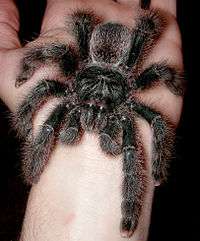 | |
| Scientific classification | |
| Kingdom: | Animalia |
| Phylum: | Arthropoda |
| Class: | Arachnida |
| Order: | Araneae |
| Family: | Theraphosidae |
| Genus: | Avicularia |
| Species: | A. metallica |
| Binomial name | |
| Avicularia metallica Ausserer, 1875, nom. dub. | |
Avicularia metallica is considered to be a doubtful name (nomen dubium), and as of March 2017 is not accepted as a valid species by the World Spider Catalog.[1]
A species is known by this name in the pet trade, where it may be called the whitetoe tarantula.[2] It is a relatively docile species of tarantula,[3] and is considered by some to be a communal species.[4] Cannibalism, while still a concern when kept communally, is less problematic compared to other Theraphosidae.[5]
Description
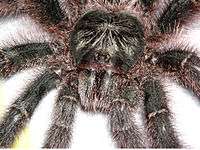
The metallic pinktoe is a tarantula with a diagonal leg span of approximately 13–15 centimetres (5.1–5.9 in). The metallic pinktoe is noted for iridescent sheen, green to dark blue prosoma, and the white tipped hairs on the opisthosoma. Males and females look the same until the ultimate (final) molt of the males. At this point, males will gain embolus on the pedipalps and tibial apophysis (also called tibial spurs or tibial hooks), used for mating. The metallic pinktoe tarantula is an arboreal species that will often construct a tube web in the tree canopy.
Habitat
The metallic pinktoe is very common in the tropical forests of Colombia and the Guiana Shield.
Pets
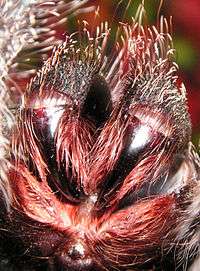
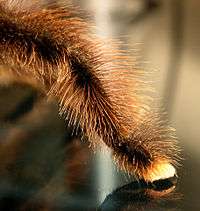
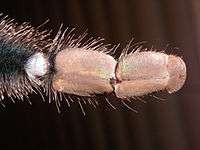
The metallic pinktoe is often kept as a pet and is popular with tarantula keepers for its metallic hue. Typical care requirements include a 5–10 US gallons (19–38 l; 4.2–8.3 imp gal) tank with 6–10 centimetres (2.4–3.9 in) of substrate such as peat moss or coco-husk.[6] Since this species is arboreal, height is more important than floor space, and they should be provided with branches, plants, or cork bark to climb on. They require relatively high humidity and should be provided with an open water dish. Tarantulas are generally offered 1–2 prey items (such as crickets) once weekly, although they can typically survive for several weeks without food. For more information on pet tarantula care see Tarantula.
Notes
- ↑ "Gen. Avicularia Lamarck, 1818", World Spider Catalog, Natural History Museum Bern, retrieved 2017-03-10
- ↑ Common Names Of Arachnids. Fifth Edition, 2003. The American Arachnological Society, Committee on Common Names of Arachnids.
- ↑ Arachnophiles Anonymous Home Page
- ↑ Avicularia species descriptions Archived December 18, 2010, at the Wayback Machine.
- ↑ Pinktoe tarantula (Avicularia avicularia) Archived July 26, 2011, at the Wayback Machine.
- ↑ Schultz, Stanley A. The Tarantula Keeper's Guide: Comprehensive Information on Care, Housing, and Feeding. Barrons, 2009. ISBN 0-7641-3885-5